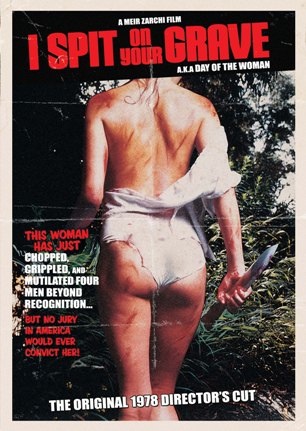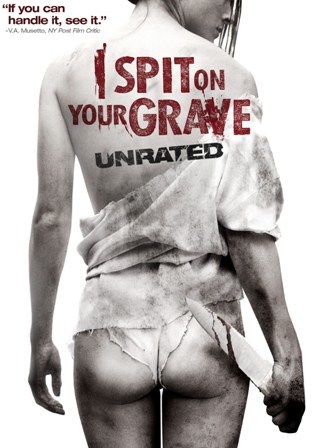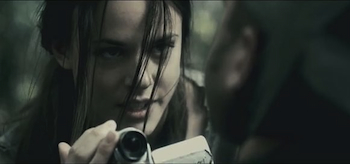 I Spit on Your Grave (Anchor Bay Entertainment, 1978 and 2010)
I Spit on Your Grave (Anchor Bay Entertainment, 1978 and 2010)
Just in time for Valentine’s Day (look, it wasn’t me who scheduled these for early February release), the rape-revenge grindhouse legend and its remake. In a weak moment I ordered these, they showed up in my mailbox (pus and viscera were leaking from the package) and now I have to deal with them. To avoid fainting, keep repeating…it’s only a review…only a review…only a review…
The Story, 1978: I quoted the tagline from The Last House on The Left (1972) above to show that I Spit on Your Grave, the movie that incensed Roger Ebert here and was designated a “video nasty” in the UK, didn’t spring from nowhere–it had predecessors on the lower end of the cinema scale, particularly Wes Craven’s disturbingly vÁ©ritÁ©-like opus. But it also had Hollywood models, too. The end of the Production Code in 1968 freed rape, that most humiliating (and exploitative) of crimes, from the cinematic closet, and pretty soon everyone was getting raped–Susan George (Straw Dogs), Adrienne Corri (A Clockwork Orange), Candice Bergen (The Hunting Party), Raquel Welch (Hannie Caulder), Ned Beatty (Deliverance). Etc. “All I do in this movie is get raped and have orgasms,” Bergen sighed of The Hunting Party (1971), a western where her character’s rape by bandit Oliver Reed frees her to have orgasms–an attitude that showed that the studios hadn’t quite had their consciousness raised since 1967, where James Coburn’s outlaw in the comedy Waterhole #3 could call rape “assault with a friendly weapon.”
By 1974’s Death Wish, Charles Bronson was fighting back, avenging the assaults on wife Hope Lange (Mrs. Muir!) and his daughter. Then sisters were doing it for themselves, in that same year’s Act of Vengeance and the glossy Lipstick (1976), where the law’s failure obliges fashion model Margaux Hemingway to take a shotgun to Christopher Sarandon’s pig photographer after he’s forced himself on her and her sister (played by the teenaged Mariel). It was in that bicentennial year that Israel-born Meir Zarchi took to the woods of Connecticut to film his far more downmarket Day of the Woman, also starring famous progeny (in this case Camille Keaton, the grand-niece of Buster Keaton).
 The story has a brute simplicity. Urbanite Jennifer (Keaton) takes a house in the country to get away from it all and work on her craft. She immediately draws the attention of townie layabouts, who jeer at “New York broads” and harass her, just enough to get under her skin. Her unwitting provocation (her first act upon arriving at her lake house is to take a nude swim) proves too much for these simpletons, and in the 25-minute centerpiece of the film they take turns raping her, outdoors and indoors, in long, punishing takes. Afterwards the goons oblige one of their number, the local halfwit, to kill the grievously violated woman, which he fails to do but won’t admit to his peers. In the real world the victim might gather her senses and report the crime to the local authorities, but as we know from past filmic experience this would be futile. Instead Jennifer prays for forgiveness for her coming wrath at the local church, gathers up various implements of destruction, and over the course of the rest of the film leaves her five assailants cut, chopped, broken, and burned beyond recognition–but no jury on earth will ever convict her.
The story has a brute simplicity. Urbanite Jennifer (Keaton) takes a house in the country to get away from it all and work on her craft. She immediately draws the attention of townie layabouts, who jeer at “New York broads” and harass her, just enough to get under her skin. Her unwitting provocation (her first act upon arriving at her lake house is to take a nude swim) proves too much for these simpletons, and in the 25-minute centerpiece of the film they take turns raping her, outdoors and indoors, in long, punishing takes. Afterwards the goons oblige one of their number, the local halfwit, to kill the grievously violated woman, which he fails to do but won’t admit to his peers. In the real world the victim might gather her senses and report the crime to the local authorities, but as we know from past filmic experience this would be futile. Instead Jennifer prays for forgiveness for her coming wrath at the local church, gathers up various implements of destruction, and over the course of the rest of the film leaves her five assailants cut, chopped, broken, and burned beyond recognition–but no jury on earth will ever convict her.
That last bit is the infamous tagline to I Spit on Your Grave, as the film was renamed in 1978 when it failed to take off under Zarchi’s preferred title. It’s not accurate–there are four rapists, and only some clothes are burned–but it was effective. (Amusingly, the cover art of the DVD corrects the hyperbole, as if an angry buyer–“she only killed four guys and didn’t burn any of them!”–might sue.) Long story short (you’ll hear it from the filmmaker in the supplements) there’s no honor among thieves and the movie never really capitalized on Ebert’s outrage at the boxoffice. It did, however, clamber from the ooze and onto videocassette (remember the hardcore horror label Wizard Video?) which is where I saw it, in 1983.
I’d considered myself fairly shockproof at age 18, but that drawn-out rape sequence, which never flinches from the full horror of the act, rattled my nerves. It remains unpleasant and unsettling, the worst part being when the perpetrators take a break from trashing Jennifer to trashing her work, adding gratuitous insult to terrible injury. Then and now, the rest of the film is a comparative breeze; clad in virginal white, Jennifer woos and cajoles the men to their not-altogether-credible deaths in the sylvan setting, which Zarchi may have intended for us to experience as a very grim fairy tale. There’s one tense moment, when the lead assailant blames her and her presumably loose-living city ways for her misfortune, throwing her off balance. But this complication is brushed aside and he (and any male in the audience who has enjoyed her earlier degradation) gets his just desserts.
 The Story, 2010: The remake’s director, Steven D. Monroe, saw the original about the same time I did, in its grungy VHS incarnation. He has several obscure horror and Syfy credits to his name (Zarchi, credited as executive producer, has made only one other movie, 1985’s Don’t Mess With My Sister!) and the new one, like the 2009 update of The Last House on the Left, has a professional sheen to it. The stillness and stark naturalism of the original is gone from the start, as a score kicks in; there is no music in Zarchi’s, and its presence here, however ominous the chords, is immediately reassuring, as are the constant flurries of editing. In contrast to 1978, where Keaton (a “Playmen” model who was no babe in the exploitation woods) was the only pro among over-the-top draftees, there are semi-familiar faces in the cast. Lead Sarah Butler has gone the CSI route, bad guys Jeff Branson and Andrew Howard (a Welshman, as if such backwoods villainy needs to be imported) have toiled in TV, soaps and features, and noted character actor Tracey Walter (Repo Men, Batman, etc.) turns up as what Monroe and producer Lisa M. Hansen (day of the woman indeed) refer to in their commentary as an audience-friendly “identification figure.” I can hear Zarchi chuckling at that one. (And what is Jennifer if not an identification figure?)
The Story, 2010: The remake’s director, Steven D. Monroe, saw the original about the same time I did, in its grungy VHS incarnation. He has several obscure horror and Syfy credits to his name (Zarchi, credited as executive producer, has made only one other movie, 1985’s Don’t Mess With My Sister!) and the new one, like the 2009 update of The Last House on the Left, has a professional sheen to it. The stillness and stark naturalism of the original is gone from the start, as a score kicks in; there is no music in Zarchi’s, and its presence here, however ominous the chords, is immediately reassuring, as are the constant flurries of editing. In contrast to 1978, where Keaton (a “Playmen” model who was no babe in the exploitation woods) was the only pro among over-the-top draftees, there are semi-familiar faces in the cast. Lead Sarah Butler has gone the CSI route, bad guys Jeff Branson and Andrew Howard (a Welshman, as if such backwoods villainy needs to be imported) have toiled in TV, soaps and features, and noted character actor Tracey Walter (Repo Men, Batman, etc.) turns up as what Monroe and producer Lisa M. Hansen (day of the woman indeed) refer to in their commentary as an audience-friendly “identification figure.” I can hear Zarchi chuckling at that one. (And what is Jennifer if not an identification figure?)
Moreover his concept has been given a “torture porn” makeover. Ebert hated this one, too, but it moves along lines made familiar by Saw and Hostel. Keaton’s wounded bird quality has been superseded by Butler’s tomboyish sass; the first thing she does out in the woods (relocated to Louisiana, site of Rod Lurie’s upcoming Straw Dogs redo) is jog, and she puts up much greater resistance to her attack, which emphasizes trash-talking sadism and threats with bottles and baseball bats and fades to black when Zarchi is just ratcheting up the terror. Her “death” (cribbed from Brian De Palma’s Casualties of War) is followed by a more lurid rampage, with not-altogether-credible traps that highlight makeup effects that can be elaborated upon in the supplements. First-time screenwriter Stuart Morse updates the material with a second-hand technological angle (one of the rapists films the crime, for “found cinema” POV shots) and gives it a political edge that might have been more satisfyingly developed; one of the five (truth in advertising!) attackers is the married-with-daughter town sheriff. Curiously a scene where Jennifer prays regarding her crimes to come was shot, then relegated to the deleted scenes. Of all the heinous goings-on did Monroe decide that this would be the breaking point for sensitive viewers?
Special Features: We have to guess, as he and Hansen preoccupy their track telling us what they did and when they did it but leave out the always more compelling why. The features have the same mechanical feel as the movie, which is presented in “unrated” form, not that it received much theatrical play last year. Included is a making-of, a teaser and the theatrical trailers, a radio spot, and those deleted scenes, which would only have lengthened the already generous 108-minute running time. (Torture porn, like comedy, is better in shorter doses.)
 I’ve said it before and I’ll say it again: In a world where Greed and The Magnificent Ambersons have yet to debut on DVD the original I Spit on Your Grave is making its third appearance, and it’s made the leap to Blu-ray, too. The extras: A practiced, polished Zarchi commentary (he says the movie was based on his intervention on behalf of a rape victim); a complementary commentary by drive-in critic Joe Bob Briggs, who defends the film as staunchly pro-victim and has an uncanny knack for finishing Zarchi’s thoughts (the director mentions that he married and divorced Keaton, who later starred in a dubious and little-seen sequel of sorts called Savage Vengeance; Briggs notes that she then married Sid Luft, giving Judy Garland’s ex the distinction of having had the stars of The Wizard of Oz and I Spit on Your Grave as spouses); a new filmed reminiscence with Zarchi, who could be a member of the Knesset; and those blast-from-the-grindhouse-past trailers, TV and radio spots, and ad materials. Such showmanship back in the day!
I’ve said it before and I’ll say it again: In a world where Greed and The Magnificent Ambersons have yet to debut on DVD the original I Spit on Your Grave is making its third appearance, and it’s made the leap to Blu-ray, too. The extras: A practiced, polished Zarchi commentary (he says the movie was based on his intervention on behalf of a rape victim); a complementary commentary by drive-in critic Joe Bob Briggs, who defends the film as staunchly pro-victim and has an uncanny knack for finishing Zarchi’s thoughts (the director mentions that he married and divorced Keaton, who later starred in a dubious and little-seen sequel of sorts called Savage Vengeance; Briggs notes that she then married Sid Luft, giving Judy Garland’s ex the distinction of having had the stars of The Wizard of Oz and I Spit on Your Grave as spouses); a new filmed reminiscence with Zarchi, who could be a member of the Knesset; and those blast-from-the-grindhouse-past trailers, TV and radio spots, and ad materials. Such showmanship back in the day!
Audio/Video: The third time is the charm for the original, which for better or worse has never looked or sounded better than in this 1.78:1 anamorphic widescreen transfer with Dolby Digital 5.1 audio. Shot in desaturated color by Neil Lisk (now deceased) the slicker remake has an aspect ratio of 2.35:1 (anamorphic widescreen) and a more urgent 5.1 mix.
Bottom Line: I now think that a pregnant Monica Bellucci’s rape in the vile Irreversible (2003), staged more leeringly, is the most horrid that I’ve seen in a movie. But I Spit on Your Grave raised the bar mighty high on its depiction in its rape-happy era, when the movies turned on to its exploitative possibilities, and for all its amateurish flaws the film, surrounded by an aura of the forbidden, refuses to let you off the hook as you squirm and wriggle. The remake? It’s only a movie.




Comments